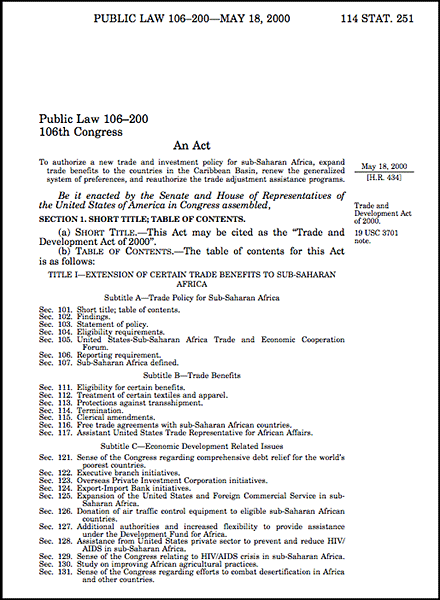AGOA II - Amendments to AGOA legislation
A number of amendments to the original terms of the African Growth and Opportunity Act were signed into law by US President George Bush during the latter part of 2002. These amendments were collectively known as AGOA II.
The AGOA II provisions amend AGOA as follows:
- To clarify that preferential treatment is provided to knit-to-shape articles or “wholly assembled” apparel articles assembled from the U.S. or from another Sub-Saharan African beneficiary country. AGOA allows knit-to-shape articles to qualify, but the knit-to-shape components have to be from the U.S. or from another Sub-Saharan African beneficiary country, or be knit-to-shape from yarn in an eligible Sub-Saharan African country;
- To make eligible for preferences so-called “hybrid” apparel articles (that is, articles containing both U.S. and Sub-Saharan Africa beneficiary components and/or articles containing both fabric and knit-to-shape components). In essence, this provides preferential treatment for apparel articles that are cut both in the United States and beneficiary countries;
- To make a technical correction to allow Sub-Saharan African producers to take advantage of the AGOA benefit for merino wool sweaters;
- To “double” the apparel cap for apparel made in Africa from regional fabric made with regional yarn from 3 to 7 percent over eight years. In addition, the Act doubles the “cap”, or annual quantitative limit, on apparel articles assembled in beneficiary countries from regional fabric. However, it does not increase the cap for apparel assembled in lesser developed beneficiary countries from third country fabric (fabric formed outside the United States or a beneficiary country); and
- To allow Namibia and Botswana to benefit from the “lesser developed beneficiary sub-Saharan African country” provision. The Trade Act also grants AGOA lesser developed beneficiary country status to Botswana and Namibia, allowing producers there to use third country fabric in qualifying apparel.
The table provides an overview of changes from "AGOA I" to "AGOA II"
| Category | AGOA I | AGOA II |
|---|---|---|
| Knit-to-Shape | The term "fabric" interpreted by US Customs as excluding components that are "knit-to-shape" (i.e. components that take their shape in the knitting process, rather than being cut from a bolt of cloth). | Knit-to-shape apparel qualifies for AGOA benefits. |
| Lesser Developed Countries | Duty-free treatment for apparel articles assembled in less developed countries in sub-Saharan Africa, regardless of origin of fabric. | LDC apparel eligible for duty-free treatment regardless of origin of fabric and regardless of origin of yarn. |
| Botswana and Namibia | Not treated as less developed countries because per capita GNP in 1998 exceeded $1 500. | Specially designated as less developed countries. |
| Hybrid Cutting | Under US Customs interpretation, cutting of fabric must occur either in US or AGOA countries, but not both. | Hybrid cutting (i.e. cutting that occurs both in US and in AGOA countries) does not render fabric ineligible. |
| Volume cap on duty-free treatment for apparel made from fabric made in AGOA region or, for lesser developed beneficiary countries from fabric made anywhere. | Applicable percentages increase through October 1, 2007. | Applicable percentages doubled. |




